In Myanmar, 2.3 million people were affected by cyclone Nargis. Millions lost their shelter, especially the ‘squatters’ who did not have a land and occupied some of the unhealthy lands as their shelter base.
There were many others who lost their near and dear ones killed in the cyclone. Where the parents died, the children have aged overnight, thrust with the responsibility of surviving and supporting other siblings.
Myanmar Rehabilitation Initiative (MRI) gives face to the numbers that emerged after the cyclone through these simple stories. Most of these stories come from villages near the sea beyond Phyapone Town in the Delta region of Myanmar. MRI has been involved in the rescue, relief and rehabilitation phase of the post-Nargis reconstruction in Myanmar. The stories come from its work in four major areas of intervention:
- Emergency Assistance, Food and Non-food – clothing, medicine and shelter
- Emergency Shelter – particularly to the landless poor houses
- Back to School – to encourage affected families to send their children back to school
- Livelihood Regeneration – helping the poor in short term and long term recovery efforts
Going Back to School
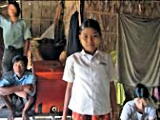 Zin Myo Khet, age 9, girl child. She lost her two sisters. Her house was completely washed away. That night, she was in the water for 8 hours with her father and mother. Now she is working in another man’s prawns and fish farm. She remembers her two sisters and often cries when she sees the river. When we met her she was not going to school. Along with others, she received a set of uniform, books and other educational needs and she will be returning to school. Her family is given micro-enterprise assistance and 25 ducks to begin anew.
Zin Myo Khet, age 9, girl child. She lost her two sisters. Her house was completely washed away. That night, she was in the water for 8 hours with her father and mother. Now she is working in another man’s prawns and fish farm. She remembers her two sisters and often cries when she sees the river. When we met her she was not going to school. Along with others, she received a set of uniform, books and other educational needs and she will be returning to school. Her family is given micro-enterprise assistance and 25 ducks to begin anew.
Helping to rebuild through Micro Enterprises
A bread winner at the age of 14
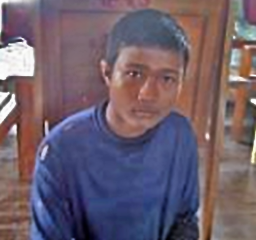 At the young age of 14, Maung Kyaw Hiet Pine has a new name, "Orphan." He is from Svuadagon village near Phyapone. The ferocious waves on that fateful night killed his father, mother and three sisters. His parents and the youngest sister were separated by water. He was with two other sisters, grabbing them from hungry waves for more than two hours, before he lost strength and let them go. He shouted for help but none came and he hung to a tree the whole night. With huge snakes passing by and with some dead bodies floating across he held on till morning. In the morning he searched for his parents and siblings and found them dead. Now he is with his grandmother. He is lonely and sad without a family. He is willing to start life as a bread winner. MRI will support his small business efforts. As of now he will start with some poultry and some piglets.
At the young age of 14, Maung Kyaw Hiet Pine has a new name, "Orphan." He is from Svuadagon village near Phyapone. The ferocious waves on that fateful night killed his father, mother and three sisters. His parents and the youngest sister were separated by water. He was with two other sisters, grabbing them from hungry waves for more than two hours, before he lost strength and let them go. He shouted for help but none came and he hung to a tree the whole night. With huge snakes passing by and with some dead bodies floating across he held on till morning. In the morning he searched for his parents and siblings and found them dead. Now he is with his grandmother. He is lonely and sad without a family. He is willing to start life as a bread winner. MRI will support his small business efforts. As of now he will start with some poultry and some piglets.
Vegetable Vendor
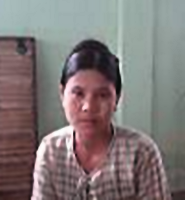 Khine Mon is a girl of 16 years from Khan Su village. She is alone. Her whole family perished when the boat they were traveling in sank during the storm. Without a family, she was taken to the Swadagone village. She stopped her studies long ago. With sorrow slowly fading away, she is looking for livelihood options and her choice is to become a vegetable vendor like her mother. MRI will support her small business aspirations. A small shop and seed money will be given to start her vegetable business.
Khine Mon is a girl of 16 years from Khan Su village. She is alone. Her whole family perished when the boat they were traveling in sank during the storm. Without a family, she was taken to the Swadagone village. She stopped her studies long ago. With sorrow slowly fading away, she is looking for livelihood options and her choice is to become a vegetable vendor like her mother. MRI will support her small business aspirations. A small shop and seed money will be given to start her vegetable business.
Most of the livelihood initiatives by NGOs concentrate on landed farmers, with seeds and fertilizers and farm equipment. MRI does contribute towards seed distribution but pays special attention to the landless poor and their livelihood regeneration through small businesses like poultry, piglets and goats.
Victim and Saviour – Rebuilding Shelters, Rebuilding Lives
 Rev Sandaw Ba Thar (pictured right), age 36, hides a huge sorrow. The monk lost his father, mother, uncle, sister and his sister’s family. None of them were found so far. The head monk of his monastery is also dead. With the head monk gone, Rev Sandaw Ba Thar has the duty to look after the rebuilding of the monastery. In our visit to his village near Swadagon, the monk actively participated in our relief works.
Rev Sandaw Ba Thar (pictured right), age 36, hides a huge sorrow. The monk lost his father, mother, uncle, sister and his sister’s family. None of them were found so far. The head monk of his monastery is also dead. With the head monk gone, Rev Sandaw Ba Thar has the duty to look after the rebuilding of the monastery. In our visit to his village near Swadagon, the monk actively participated in our relief works.
He has also promised to play a major role in rebuilding the houses of the people. Nearly 50 people were killed by the storm. He will be MRI’s local partner in the plan to repair and rebuild 56 houses for the homeless in the village. Thousands of houses need rebuilding in the coastal villages where logistics and access restrictions remain a very big challenge to all the NGOs.
And Elsewhere…a home at last
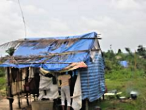 Homelessness has emerged as one of the major problems in the post-Nargis phase. The land ownership in Myanmar is with the government and most of the poor are left without any land deeds. This has forced them to live in areas vulnerable to floods and other natural disasters. Most of the poor, who were officially ‘squatters’ for generations, were the worst victims in the disaster. Since they do not have land deeds, not many NGOs would come forward to help them with the repairs and rebuilding of shelter.
Homelessness has emerged as one of the major problems in the post-Nargis phase. The land ownership in Myanmar is with the government and most of the poor are left without any land deeds. This has forced them to live in areas vulnerable to floods and other natural disasters. Most of the poor, who were officially ‘squatters’ for generations, were the worst victims in the disaster. Since they do not have land deeds, not many NGOs would come forward to help them with the repairs and rebuilding of shelter.
MRI selected 150 of them in Thingagyn in Yangon and Kyataun in the outskirts of Yangon to build houses. Most of the houses in Burma were built with bamboo and thatch roofs, often destroyed in the yearly monsoon rains. Nargis destroyed 90% of such dwellings of the poor.
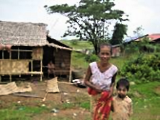 MRI plans to target these most vulnerable people whose livelihood depends on proper dwelling. Mathayee is one such beneficiary. For generations her house was near a small lake, often water-logged during the rainy season. Now she has moved to a higher ground and MRI is helping in building her hut where her son and his family will be living with her. This will provide the family some protection from the monsoon rains and a place for the children to study. Under normal circumstances, these bamboo and thatched-roof houses will last for two years.
MRI plans to target these most vulnerable people whose livelihood depends on proper dwelling. Mathayee is one such beneficiary. For generations her house was near a small lake, often water-logged during the rainy season. Now she has moved to a higher ground and MRI is helping in building her hut where her son and his family will be living with her. This will provide the family some protection from the monsoon rains and a place for the children to study. Under normal circumstances, these bamboo and thatched-roof houses will last for two years.
Apart from these responses, the MRI distributed large amounts of emergency aid during the first month, reaching some of the remote areas, carrying food, shelter materials, medicines, emergency clothing materials, sleeping materials, hygiene kits and others as needed.

